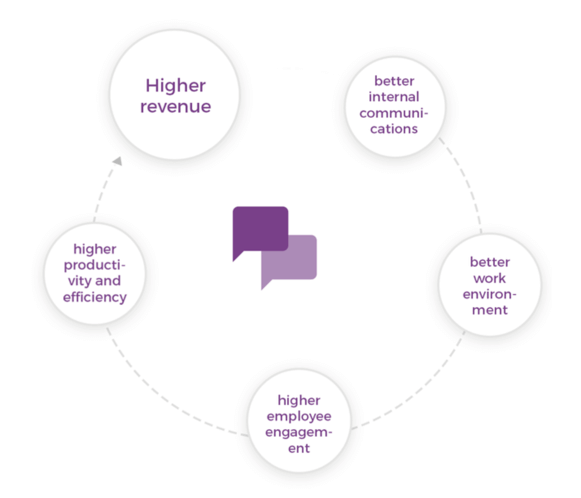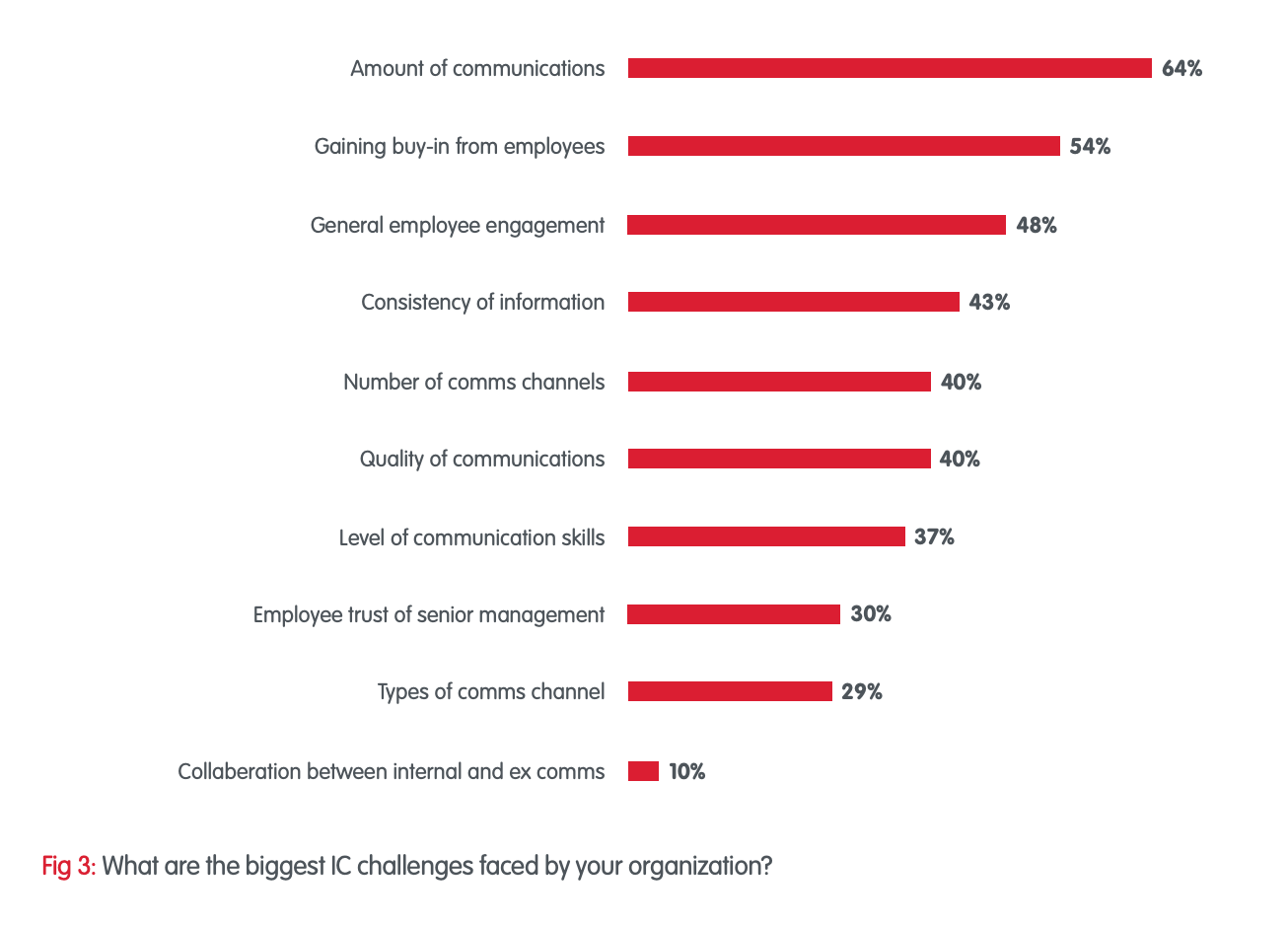Your internal communication strategy has a tremendous impact on your business’s bottom line.
The way you communicate your company’s vision and your goals to your employees has a direct impact on their performance and ability to grow your business.
📕Download our free ebook “Building a Better Company with Internal Communications” where we share tips to help you craft a successful internal communication strategy!
Staffbase found that effective internal communication leads to a 40 percent increase in customer satisfaction, a 30 percent increase in profitability, and a 36 percent increase in the overall performance of a company.
However, there are plenty of myths and misconceptions about internal communications that may lower employee engagement and slow down your business.
In this blog post, we’ve picked 5 of the most common internal communication myths you need to forget right now if you want to take your business to the next level.
Are you ready? Let’s dive in!
Myth #1: Internal Communication Belongs to One Department
Your internal communication team is obviously responsible for crafting your internal communication strategy and making sure that everyone has a great understanding of the business overall and how they contribute to the company’s bottom line.
Your IC managers implement and develop your internal communications and they make sure that employees get the right information at the right time. They are in charge of defining clear goals and objectives, crafting the IC strategy, and inspiring employees.
Let’s break down their main responsibilities as bellow:
Main Internal Communication Professionals’ Missions
- Setting clear internal communications goals
- Developing messages and setting the tone of voice
- Segmenting internal audiences and finding the right channels to reach the right employees at the right time
- Identifying the type of content that drives adoption throughout the organization
- Ensuring that the IC strategy is aligned with the company’s mission statement
- Enhancing dialogues in the workplace
- Motivating and inspiring employees
- Driving employee engagement through effective internal communications
- Helping employees find meaning in their work
- Helping employees understand how their work contributes to the company’s success
Related: What is Internal Communication? We asked 16 experts to spill the beans.
However, the rest of your organization shouldn’t be excluded from your internal communication strategy!
Indeed, IC professionals collaborate with HR and IT and depending on the organizational structure, they may report to HR or the Corporate Communications department.
What’s more, your IC managers need to collect feedback and insights from employees. IC is not about sending out information to the workforce but fostering dialogues in the workplace.
Related: Internal Communications (IC): The What, Why, Who and How
You’ll need to get everybody on board to enhance open and transparent communications in your workplace. This is one of the best ways to build trust and drive adoption.
Of course, your employees won’t craft the internal communications strategy, but they can provide you with valuable feedback that will help you improve your internal communications.
What’s more, some of them may even be interested in creating informative content they can share internally to enhance collaboration within the organization.
At the end of the day, everyone has a role to play in internal communications!
Myth #2: Employees Have a Clear Understanding of the Company’s Vision and Mission Statement
When it comes to internal communications, don’t assume that all your employees have a clear understanding of your company’s vision and mission statement.
Even though it makes sense that employees know where the business is heading, they don’t in most organizations.
Think about it: North America Workforce found that 60 percent of employees don’t know what their company’s vision is.
How can you make sure that all your employees are aligned with your company goals and believe in your product if they don’t know where the business is heading?
What’s more, only 21% of internal communication professionals believe employees have a good understanding of why senior leaders make the decisions they do.
Having poor internal communications in place is one of the main reasons why employees don’t have a clear understanding of the company’s vision in most organizations.
In fact, 74% of employees have the feeling they are missing out on company news.

This lack of communication may lead to frustration and lower employee engagement.
At the end of the day, it’s your entire business that may suffer from poor internal communications!
Impacts of internal communications on your business

Myth #3: Internal Communication Is a One-Way Street
We’ve asked IC experts to explain what internal communication is, take a look at the video below:
As explained by the IC experts we’ve interviewed, internal communication is not limited to sending out company information to the workforce. It’s all about informing, inspiring, connecting, engaging, and helping employees find meaning at work.
IC requires a great understanding of the organizational structure, decision-making process, and the context in which situations happen. That’s why a good internal communications strategy involves dialogues and meaningful conversations in the workplace.
IC professionals have to ask questions and encourage employees to share key insights so they can get all the information they need to craft an effective internal communications strategy.
Related: Internal Communication: Definition, Challenges and Top Reasons Why It’s More Important than Ever
Enhancing dialogues in the workplace is also a great way to check in with employees and collect feedback on a regular basis.
It’s not easy to improve an internal communications strategy if you don’t know what needs to be changed.
Is your message clear enough, do you need to change the type of content you share internally, the channels you’re using, or the way you’re distributing your content?
Encouraging dialogues is one of the best ways to assess your current internal communications and make sure you’re on track to drive employee engagement.
Myth #4: Internal and External Communications Are Two Different Worlds
FAULSE — internal and external communications are interconnected!
Your internal and external comms may be located in separate departments, but you need to make sure that your internal and external communications teams coordinate their efforts to craft a strong brand message.
What’s more, don’t forget that the content you create for your external communications is relevant for your employees as well!
After all, your employees are your first customers: If you want them to believe in your product, you’ll need to get their buy-in!
To keep ahead of the competition, you have to make sure that the information you share internally is aligned with the brand message you send to the outside world.

What’s more, the information you communicate internally and the way you communicate it has a strong impact on your brand image overall (yes, your employees talk about your company before you even know it —welcome to the era of social media!).
The way we’re communicating is changing and you may want to take into consideration the interplay of external and internal communications to stay on top of your game!
Myth #5: You Don’t Need to Customize Your Internal Communications
Sharing the same information to your entire workforce is not the best way to engage with them!
A recent research study highlights that the sheer volume of information flowing through the organization is the challenge #1 IC professionals are facing now.
Biggest internal communications challenges faced by businesses

What’s more, 65.2% of UK employees state that the quality of their work is affected by the amount of information and data they have to process.
Now, the question is: how to prevent your employees from feeling overwhelmed by information overload?
The answer is pretty simple: it’s all about content distribution! Segment your internal audience and customize the content you internally to make sure that your employees get the right information at the right time.
Related: 5 Internal Communications Best Practices for Driving Engagement [Infographic Included]
Tailoring your internal communications is one of the best ways to support your team’s needs. And to do so, all you need to do is to adjust the information you communicate to your employees based on their role, location, the languages they speak, and the topics they are interested in.
Also, make sure your employees can customize their news feed so they only receive the information and materials they need.
🔔 Check out how Smarp can help you craft tailored internal communications!
Takeaways
Internal communications (IC) is key to growing your business. Your IC managers will help you enhance dialogues in the workplace all while inspiring your employees and helping them find meaning in their work.
Not only does an effective internal communications strategy help you ensure that all employees work collaboratively towards a common goal, it also drives employee engagement.
However, IC is not about sending over company information to the entire workforce, it involves segmenting your audience and tailoring your content according to your employees’ role in the organization and their location.
Crafting a great internal communications strategy takes time and effort, but when done right, it helps you take your business to the next level!









